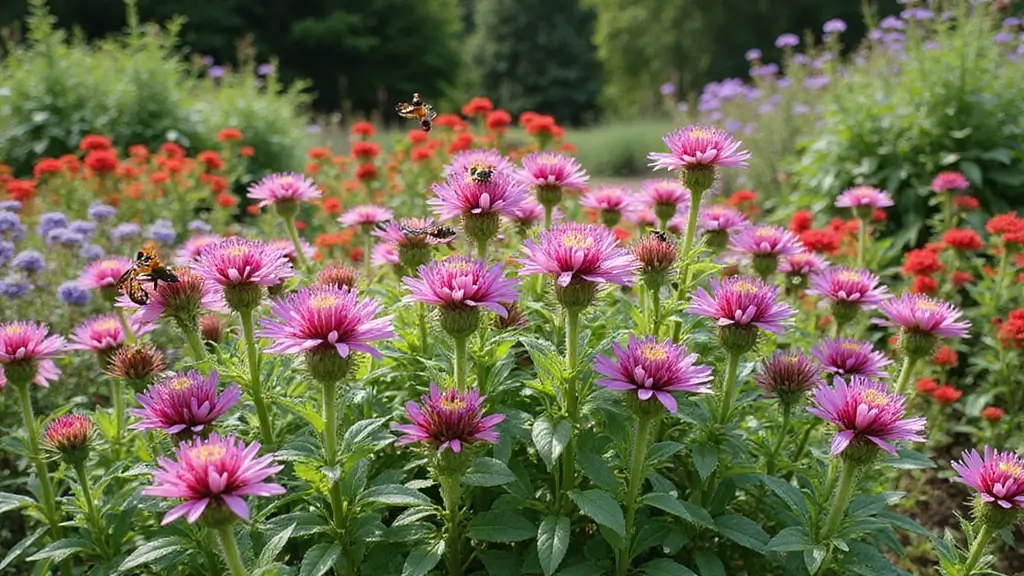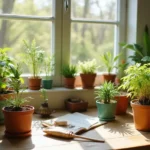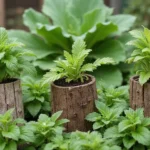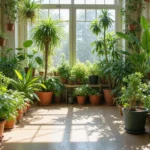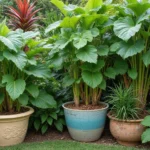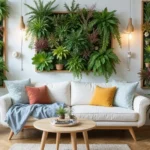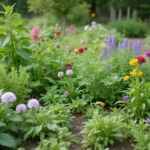With vibrant colors and a unique shape, the bee balm plant is a must-have for any garden aimed at attracting pollinators. These perennial flowers bloom in shades of pink, red, and purple, inviting a range of bees and butterflies to visit. From creating eye-catching borders to filling out wildflower meadows, bee balm offers endless possibilities for garden landscaping ideas. Perfect for both novice and experienced gardeners, this guide showcases 30 stunning ideas to incorporate bee balm into your landscape. Get ready to enhance your garden with these colorful blooms that not only look beautiful but also support the vital ecosystem of pollinators.
Whether you’re looking to create a serene cottage garden or a vibrant wildlife sanctuary, bee balm plants can play a pivotal role. Their aromatic leaves and striking flowers add texture and depth to your outdoor space. In this collection, explore how to use bee balm creatively, ensuring you have a garden that is both gorgeous and beneficial for nature.
1. Cottage Garden Charm
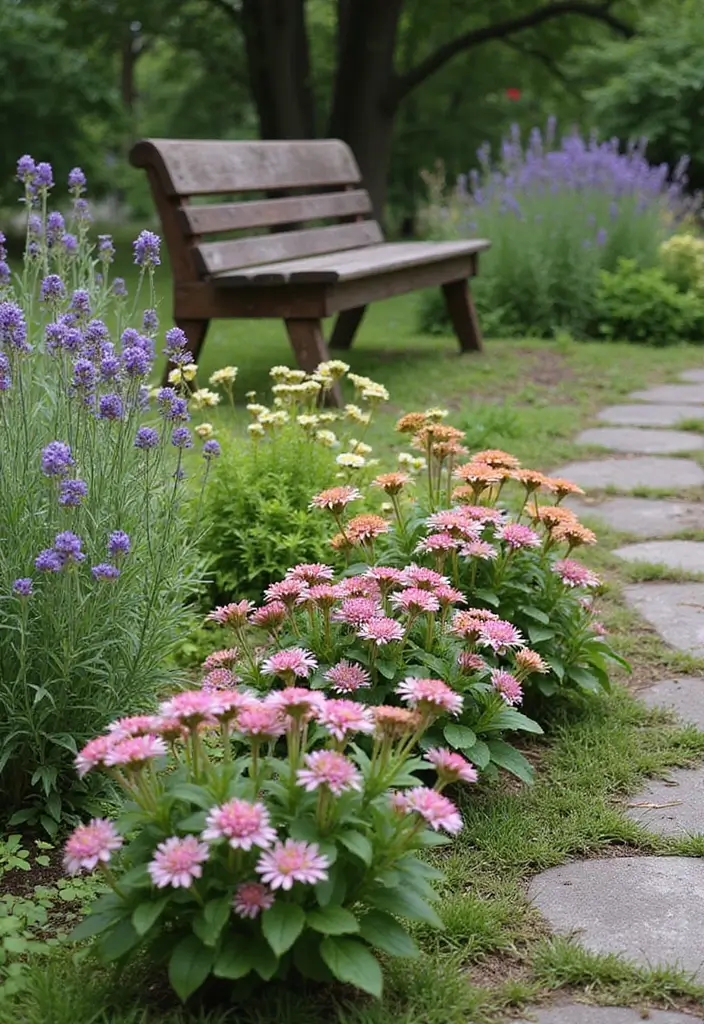
Bring the classic cottage garden feel into your outdoor space by incorporating bee balm plants among your perennials. This type of arrangement features a mix of tall and short flowers, allowing the bee balm’s vibrant hues to stand out beautifully. Pair them with daisies, delphiniums, and lavender for a classic, whimsical look. Consider a few rustic garden accessories like wooden benches or trellises to enhance the charm.
When planting, make sure to group your bee balm in clusters for a fuller look, and allow them enough space for air circulation to prevent mold. This layout attracts a variety of pollinators, making your garden not just beautiful, but alive with activity.
With proper bee balm care, including adequate watering and sun, your cottage garden can thrive. Adding pathways lined with stones or mulch can also make it inviting and accessible.
2. Bold Borders
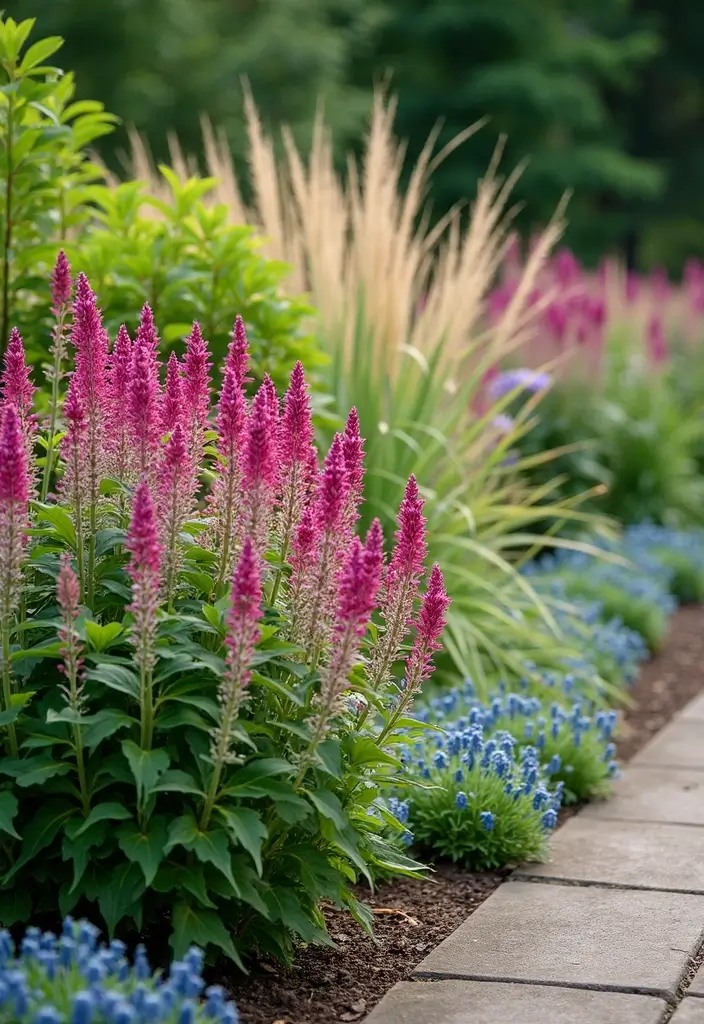
Use bee balm to create stunning borders around your garden beds. Their upright stature and noticeable blooms make them ideal for lining paths or garden boundaries. Choose a variety of colors for a striking visual impact, or stick to a color palette for a more cohesive look. When planning your borders, consider the height of the plants to ensure the base flowers don’t get overshadowed.
Add contrasting plants, such as ornamental grasses or shorter perennials, for added texture. This design not only highlights the beauty of the bee balm but also encourages pollinators to explore the garden further.
For the best results, keep your soil rich and well-draining, and remember to deadhead spent flowers to promote further blooming. With some care, these borders will become a focal point of your landscape.
3. Pollinator Paradise

Transform your garden into a true pollinator-friendly paradise by planting bee balm among nectar-rich flowers. Combine them with plants like coneflowers and butterfly bush to create a haven for bees, butterflies, and hummingbirds. This combination not only attracts pollinators but can also support their health, providing essential food sources throughout the growing season.
Create a diverse planting scheme that includes various shapes and sizes, ensuring there’s always something blooming. Consider adding a small water feature or birdbath nearby to provide hydration for these important guests. A colorful, lively garden buzzing with pollinators makes for a fantastic outdoor experience.
Proper bee balm care, including regular watering and correcting soil pH, will keep your plants looking fabulous and supporting wildlife.
4. Natural Wildflower Meadow
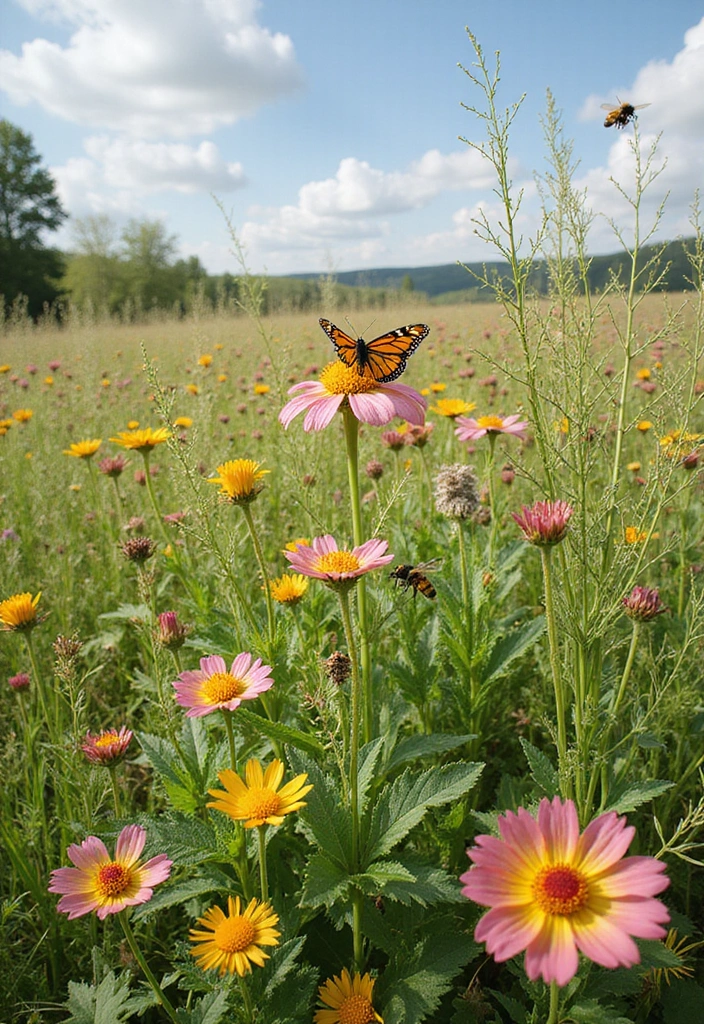
Embrace the beauty of a wildflower meadow by integrating bee balm into native plant communities. This approach not only enhances biodiversity but also makes maintenance a breeze! Mix bee balm with other native perennials and grasses for an authentic meadow look.
Leave areas of your garden undisturbed to allow natural growth and support local fauna. This will create a relaxed, natural feel while attracting a variety of butterflies and bees. For a stunning effect, plant in drifts and clusters so that your bee balm creates waves of color as they bloom.
You’ll need to monitor for weeds, but overall the maintenance will usually be less than traditional gardens. This setup promotes a thriving ecosystem that is beneficial for both you and the environment.
5. Container Gardening with Bee Balm

No garden bed? No problem! Bee balm can thrive in containers, making it a perfect option for balconies or patios. Use a combination of different pot sizes and colors to create an attractive display. Group several containers together for a cohesive look, and include other plants that thrive in sunny conditions like geraniums or petunias.
When choosing containers, make sure they have good drainage holes to prevent waterlogging. Bee balm enjoys rich soil, so add compost or other organic materials to help feed your plants. Water regularly, especially in hot summer months, to keep them looking their best.
This setup not only brightens up your outdoor space but also provides a dedicated area for pollinators to visit. You’ll be amazed at how even a small space can come alive with these colorful blooms!
6. Attractive Cut Flower Garden
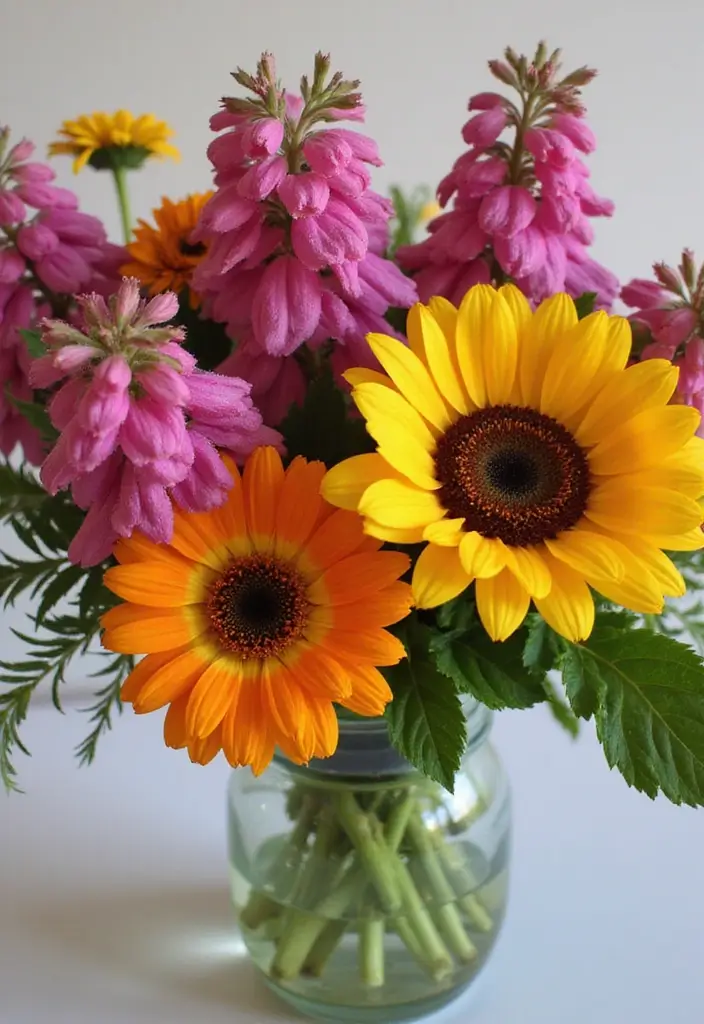
Bee balm can play a starring role in your cut flower garden. With their bold, colorful blooms, they can create stunning arrangements for your home. Plant in a designated area that receives plenty of sunlight, and consider companions like zinnias or sunflowers to balance the colors in your bouquet.
When cutting the flowers, be sure to use clean, sharp scissors and cut early in the morning for the best freshness. This encourages more blooms, so don’t hesitate to take a few flowers for your vase! The unique shape of bee balm gives arrangements a fresh look that’s perfect for any occasion.
Remember, bee balm benefits from regular division every 2-3 years to maintain healthy growth, so you can enjoy beautiful cut flowers season after season.
7. Colorful Group Planting
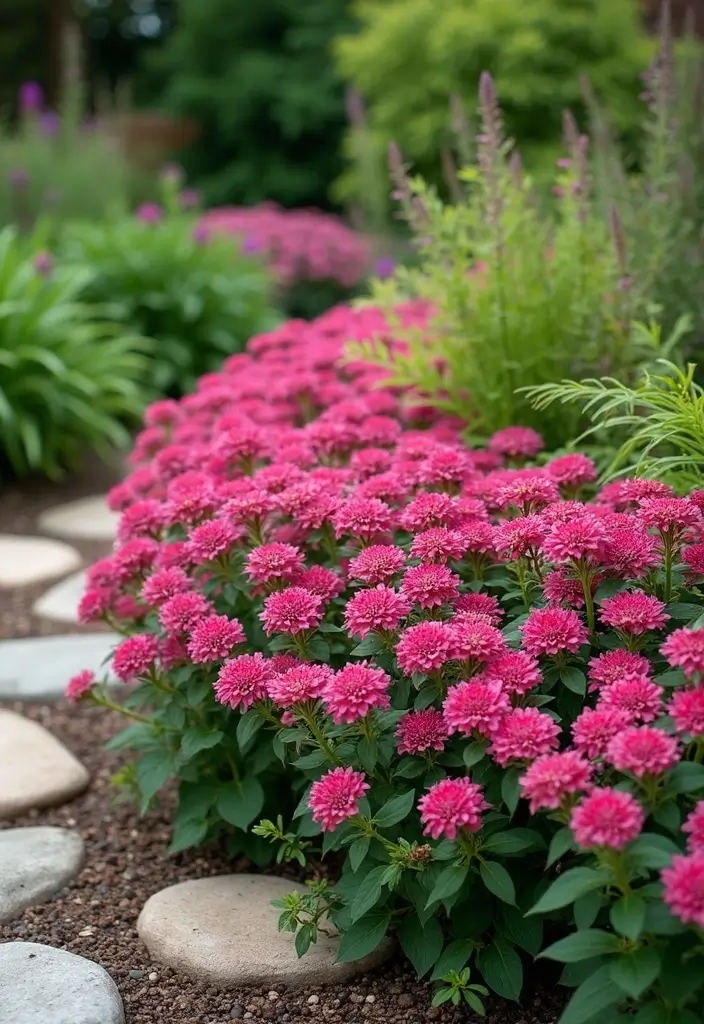
Create a visual feast by grouping bee balm plants in clusters of the same color. This technique emphasizes the specific hues and makes them pop against a backdrop of green foliage. For example, plant a deep red bee balm next to lighter blooms for a beautiful gradient effect that draws the eye.
This group planting strategy not only looks aesthetic but also provides a more inviting environment for pollinators. Consider mixing in other perennial flowers with complementary colors to enhance the overall look. Adding a few ornamental features such as stones or sculptures can provide an artistic touch.
Keep in mind that bee balm thrives in full sun, so place them in locations where they will receive at least six hours of sunlight daily. Regular deadheading will keep your clusters looking fresh throughout the blooming season.
8. Edible Landscaping
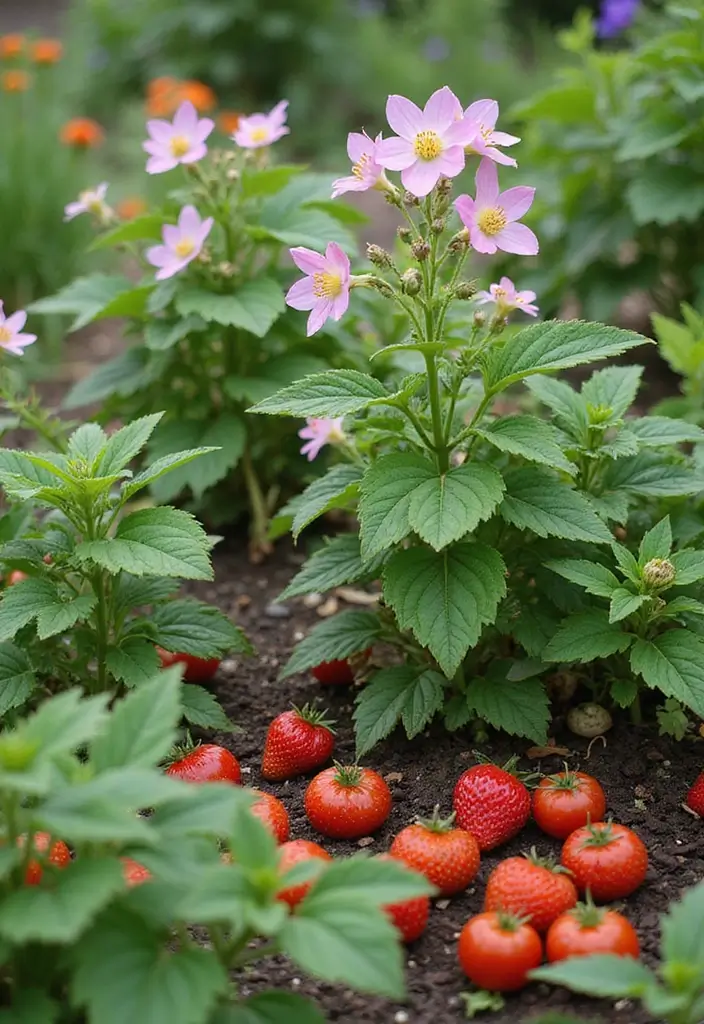
Incorporating bee balm into your edible landscape can create a stunning aesthetic while also providing flavorful leaves. Known for their minty aroma, the leaves can be used to make refreshing teas or as a culinary herb. Pair them with fruiting plants like strawberries or tomatoes for an innovative approach to landscaping.
Plan your garden layout by placing bee balm near pathways or in raised beds, ensuring easy access for harvest. Not only does this bring beauty to your edible garden, but it also attracts beneficial insects that can help with pollination.
Make sure to leave space for the bee balm to spread, as they can become quite sizable. A little care in managing their space will yield vibrant blooms and delicious leaves for your kitchen.
9. Bird-Friendly Gardens
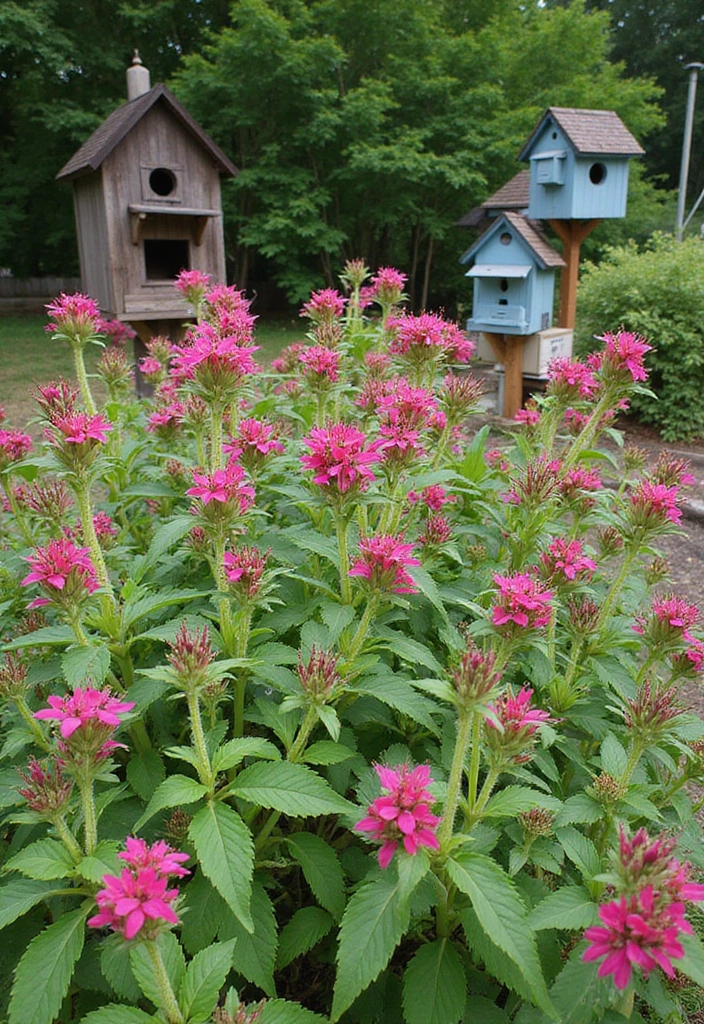
Creating a bird-friendly garden is another way to make the most of your bee balm plants. Their blooms draw in a variety of pollinators, but they can also attract birds who feast on the seeds once the blooms have faded. To enhance this environment, add birdhouses or feeders nearby, creating a sanctuary for local wildlife.
Mix bee balm with other bird-attracting plants like sunflowers or black-eyed Susans for a colorful display. This diverse planting will invite not just the bees, but also a chorus of birds, enriching your garden experience.
Ensure that you maintain a clean and safe environment for both birds and pollinators by avoiding pesticides. Keeping the habitat lively will allow for a delightful symphony of nature right in your backyard.
10. Xeriscape Gardening
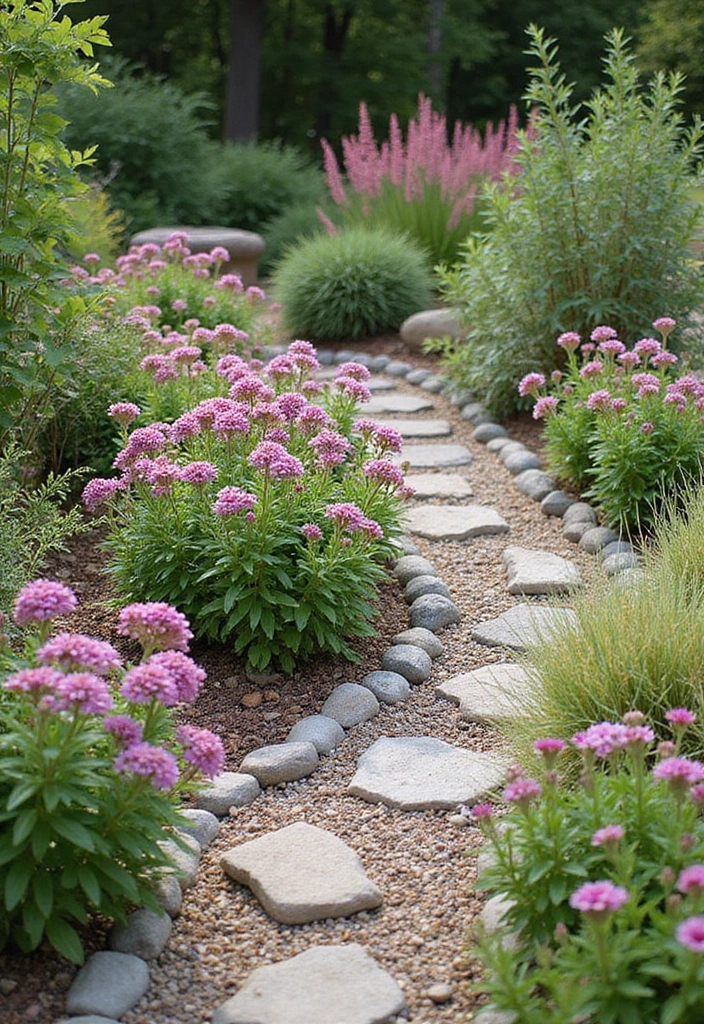
Bee balm can also be a beautiful addition to xeriscape gardens, which focus on water conservation. Although they enjoy moisture, once established, they are fairly drought-tolerant. Cluster them with other drought-resistant plants like succulents and ornamental grasses to create a striking low-water landscape.
By selecting plants that share similar water needs, you can design an efficient and visually appealing garden. Incorporate rocks or gravel to add texture and create pathways throughout your garden.
Consider adding a drip irrigation system to assist with watering during dry spells, but don’t forget to allow for natural rainfall when planning your layout. Bee balm will thrive in these conditions, providing colorful blooms while minimizing water waste.
“Create a stunning xeriscape garden with bee balm plants! Once established, they thrive on minimal water, allowing you to enjoy beauty while conserving resources. Pair them with drought-resistant friends for a low-water paradise!”
11. Shade-Loving Companions

While bee balm prefers full sun, certain varieties can tolerate partial shade. To maximize space, consider planting them alongside shade-loving companions like ferns or hostas. This creates a lush, vibrant area that flourishes in less direct sunlight.
Be mindful of the soil conditions, as shade areas may retain moisture more than sunny spots. Ensuring good drainage is essential to prevent root rot. By layering plants of various heights, you create a dynamic visual interest in the shade.
Regularly monitor these plants for signs of nutrient deficiency, as shaded areas often require an extra boost to thrive. With the right care, your shaded spaces can become lively retreats filled with beautiful blooms.
12. Climate-Sensitive Planting
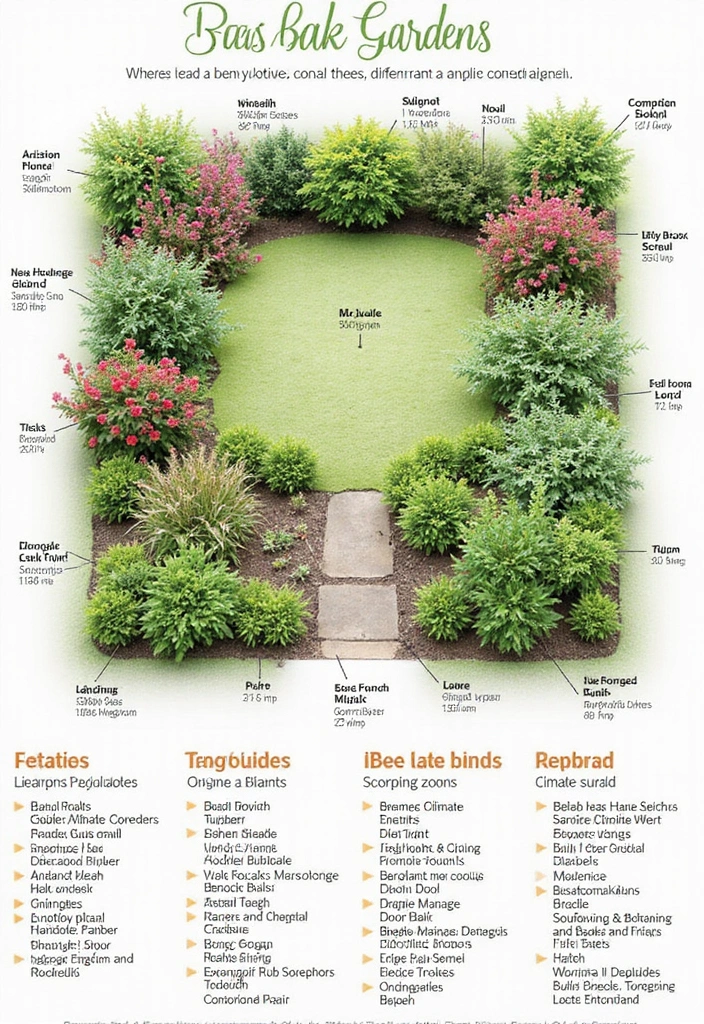
When planning your bee balm garden, consider the climate in your area. Different varieties of bee balm thrive in different conditions, so researching the best types for your specific zone is crucial. For drier, hotter areas, opt for the Monarda didyma varieties, while cooler climates may benefit from Monarda fistulosa.
Furthermore, consider the layout and how sunlight hits each area of your garden throughout the day. Grouping plants based on their sunlight and moisture requirements will ensure they flourish. Observing how your garden changes throughout the seasons will give you insights into your plants’ needs.
Pay attention to soil quality and drainage as well, as this can greatly affect how well your plants establish themselves. This careful planning will lead to abundant blooms and a healthier ecosystem overall.
13. Seasonal Color Schemes
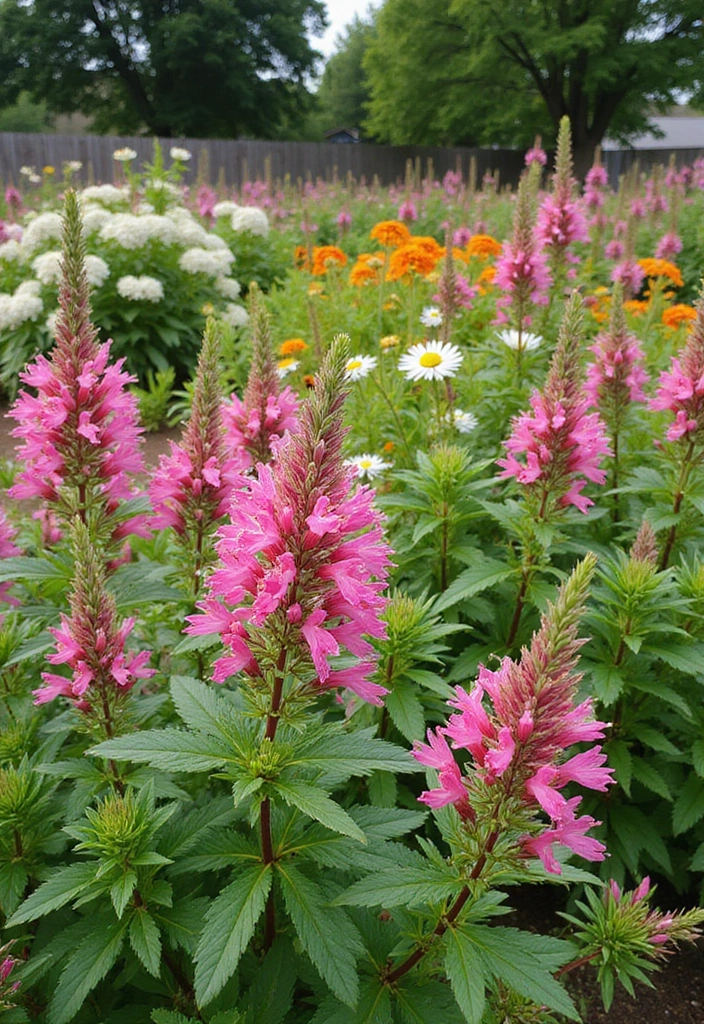
Using bee balm in seasonal color schemes can brighten your garden throughout the year. Plant different varieties that bloom at various times, creating a staggered bloom period. Pair early bloomers with mid-season varieties to keep the colors flowing.
Consider the color palette you want to achieve—monochromatic schemes with different shades of one color or complementary schemes for vibrant contrast. This approach ensures that there’s always something vibrant to attract both eyes and pollinators.
Planting in layers also allows for more coverage and texture, which will be pleasing to the eye. Not only does a well-planned seasonal scheme make for a stunning garden, but it also supports pollinator activity year-round.
A garden filled with bee balm blooms is a feast for the eyes and a sanctuary for pollinators. Embrace seasonal color schemes to keep your garden vibrant and buzzing all year round!
14. Mixed Perennial Beds
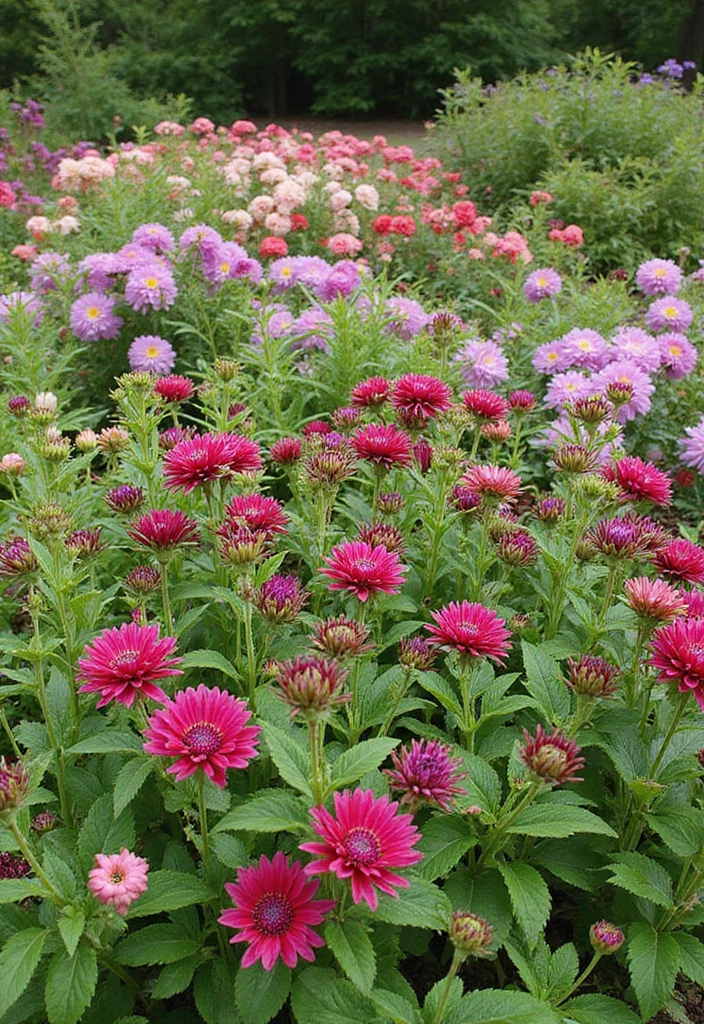
Incorporating bee balm into mixed perennial beds enhances the overall biodiversity of your garden. The vibrant flowers complement other perennials like daylilies or peonies, adding layers of color and texture. Mixing heights and foliage textures creates visual contrast and interest throughout the growing season.
When planning your mixed beds, aim for a color harmony that transitions smoothly from one plant to another. This not only makes for a beautiful display but also promotes healthy growth by fostering a balance in the ecosystem.
Regular maintenance, including deadheading and dividing, will keep your perennials healthy and ensure that your bee balm thrives in this setting. This diverse planting also invites a richer variety of pollinators to visit, enhancing your garden’s vibrancy.
15. Vertical Gardening
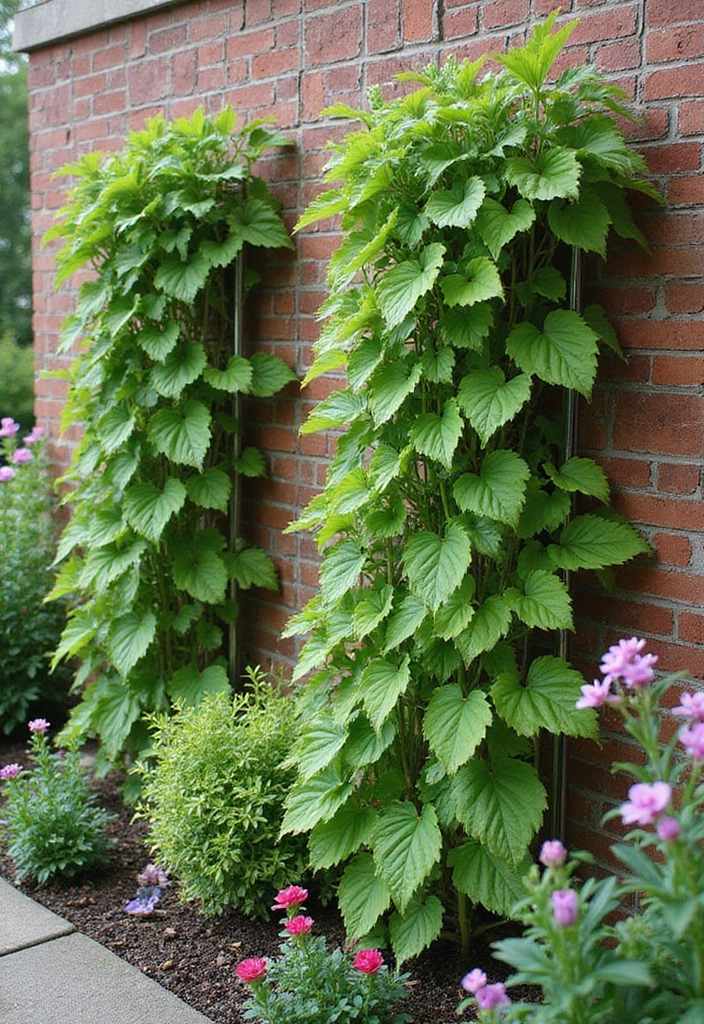
Maximize your gardening space through vertical gardening, and let bee balm climb! Using trellises or vertical planters can create a stunning display while saving ground space. Pairing bee balm with climbing plants like clematis or morning glories will add a new dimension to your garden.
When using vertical gardening, ensure that your bee balm is secured properly to allow for growth and blooming without interference. This approach creates breathtaking layers and dimension to your garden, keeping it visually appealing from every angle.
Consider incorporating herbs or smaller flowering plants at the base of your vertical setup to maximize flavor and fragrance. The combination of vertical space and colorful blooms creates an inviting atmosphere sure to impress friends and pollinators alike.
16. Bee Balm in Rock Gardens
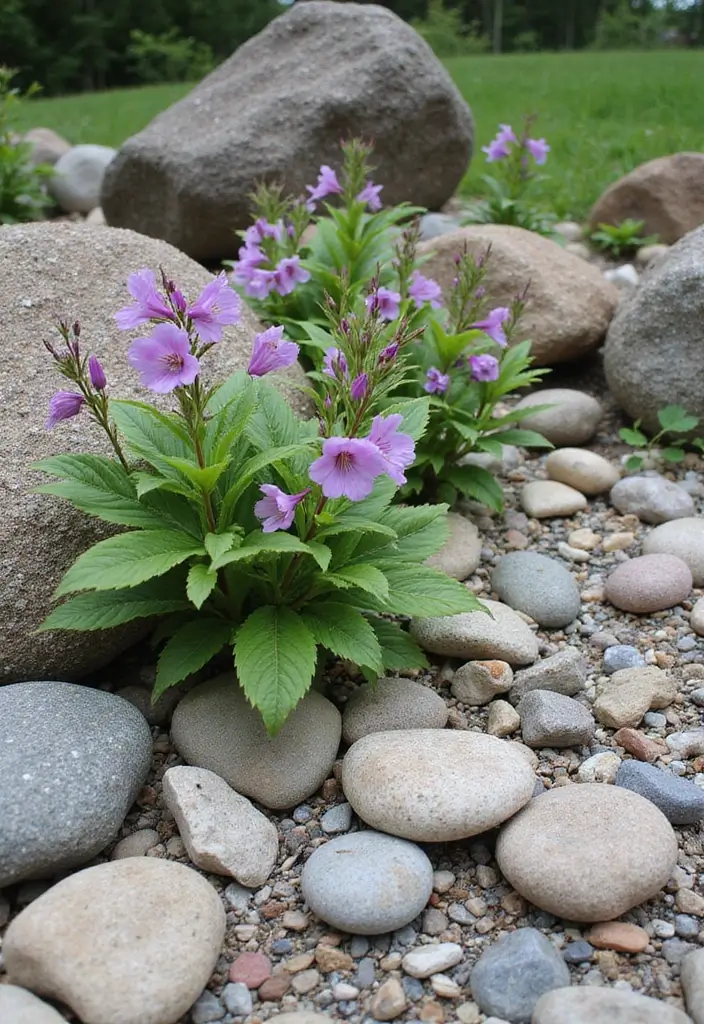
Rock gardens can look visually striking, and incorporating bee balm into these spaces adds both height and color. The rugged look of stones combined with the soft flowering of bee balm creates a stunning contrast. Choose a sunny spot to ensure your plants thrive among the rocks.
Plant the bee balm near the edges of the rock garden for maximum visibility and allow them some room to spread. The natural drainage of a rock garden suits bee balm’s growing needs well. This unique combination offers not only a beautiful aesthetic but also supports local bee populations.
Ensure your rock garden is well-maintained, removing any invasive weeds that can compete for nutrients. Regular watering during dry spells will help your bee balm flourish.
17. Family-Friendly Gardens
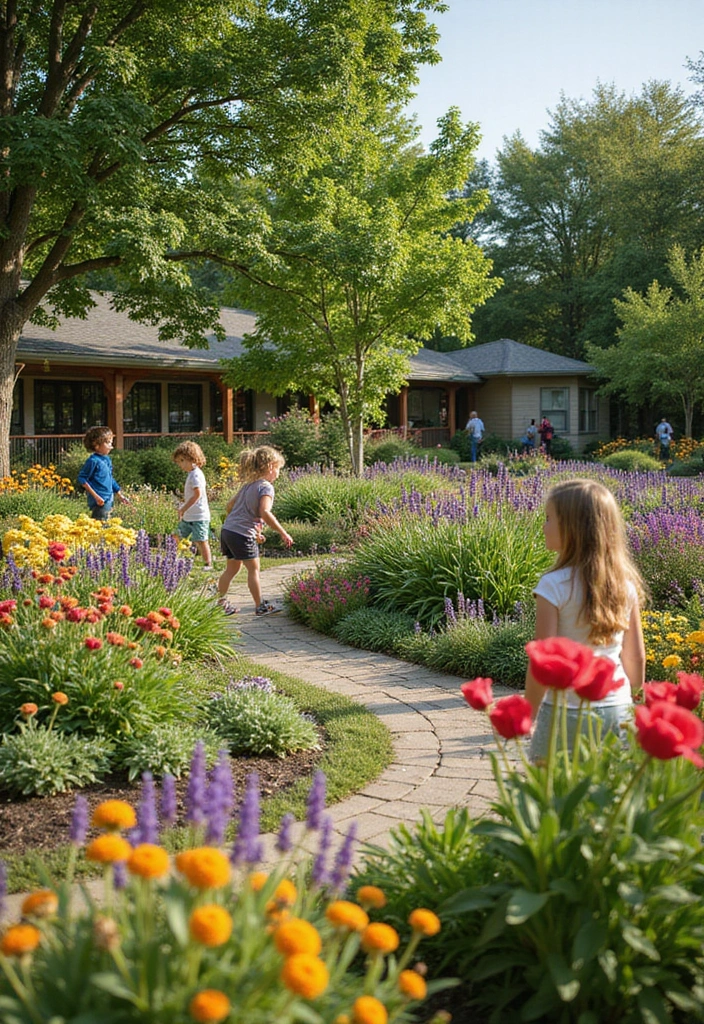
Make your garden a family-friendly space by incorporating bee balm among other sturdy plants that can withstand children’s playful antics. Bee balm’s vibrant colors are sure to attract young spectators, while its aromatic leaves can serve as a sensory experience. Pair it with plants like marigolds or sunflowers that are both colorful and resilient.
Designate specific areas for play, ensuring that bee balm and other plants are in safe zones where children can observe and enjoy the blooms up close. If you have a small garden, consider creating labeled zones showcasing the different plants, teaching kids about gardening and the importance of pollinators.
This approach not only nurtures a love for gardening but also supports pollinator health, making it a win-win for the family and the environment.
18. Wildlife Corridors
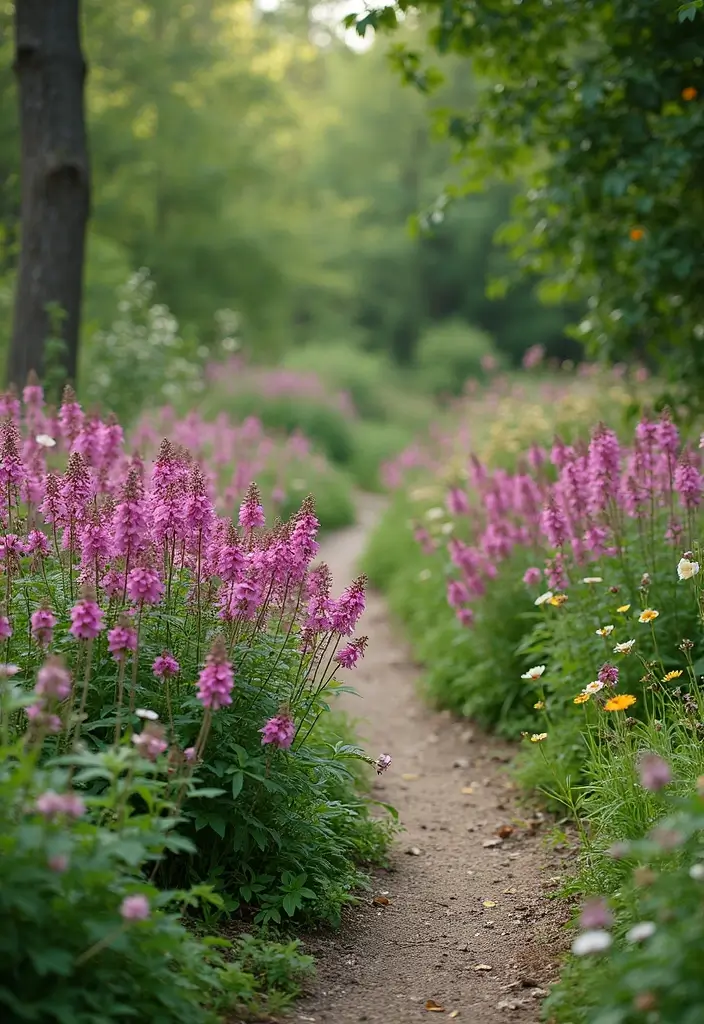
Creating a wildlife corridor in your backyard can establish a pathway for pollinators and other animals to move freely. Integrating bee balm along these paths encourages bees and butterflies to visit your garden more frequently. Plant them in clusters to mark the corridor, making it inviting for wildlife.
Include a variety of plants along the corridor to provide a diverse food source. This also benefits the health of your garden, as a wider array of plant species will support a balanced ecosystem. Consider adding native grasses or shrubs to enhance the habitat further.
With a little patience and care, your wildlife corridor will thrive, creating a vibrant path for nature right in your backyard.
19. Moonlight Garden
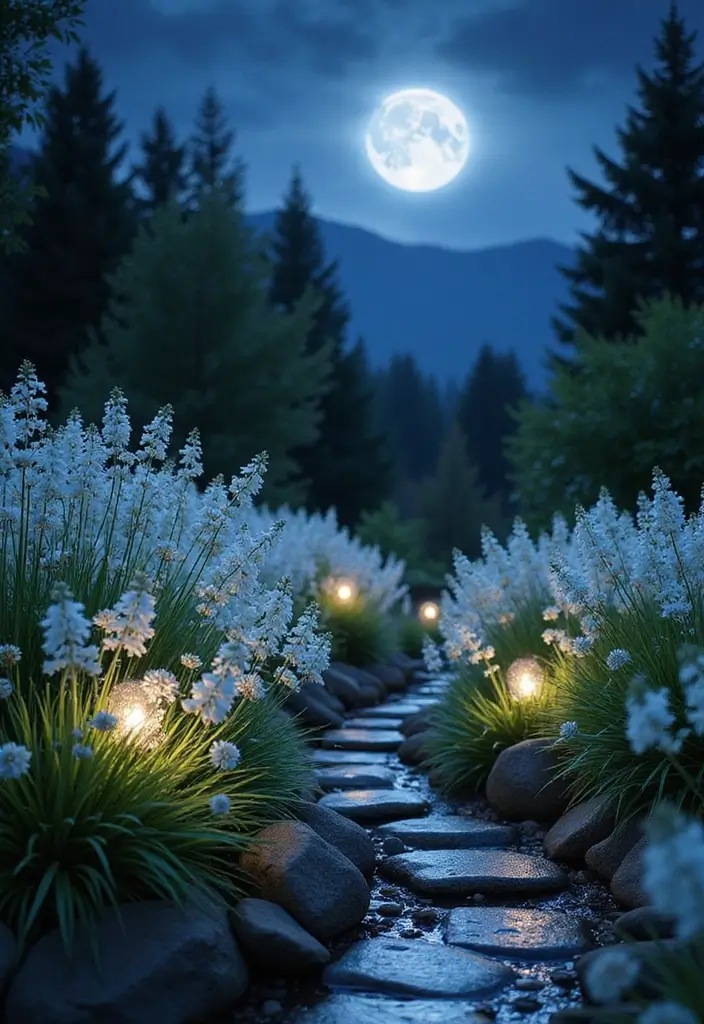
Imagine a garden that glows at night! Planning a moonlight garden with bee balm plants can create a magical atmosphere. Choose white or light-colored varieties of bee balm that shine under the moonlight, pairing them with evening-blooming plants like night-blooming jasmine.
Incorporate reflective elements like stones or mirrors to enhance the moon’s glow, creating visual interest even after the sun goes down. This enchanting garden can be a perfect retreat for evening relaxation or social gatherings under the stars.
Proper planning, considering bloom times for other plants to complement your bee balm, will enhance this dreamy setting. This garden will not only attract nighttime pollinators but also create a serene environment for nighttime enjoyment.
20. Educational Gardens
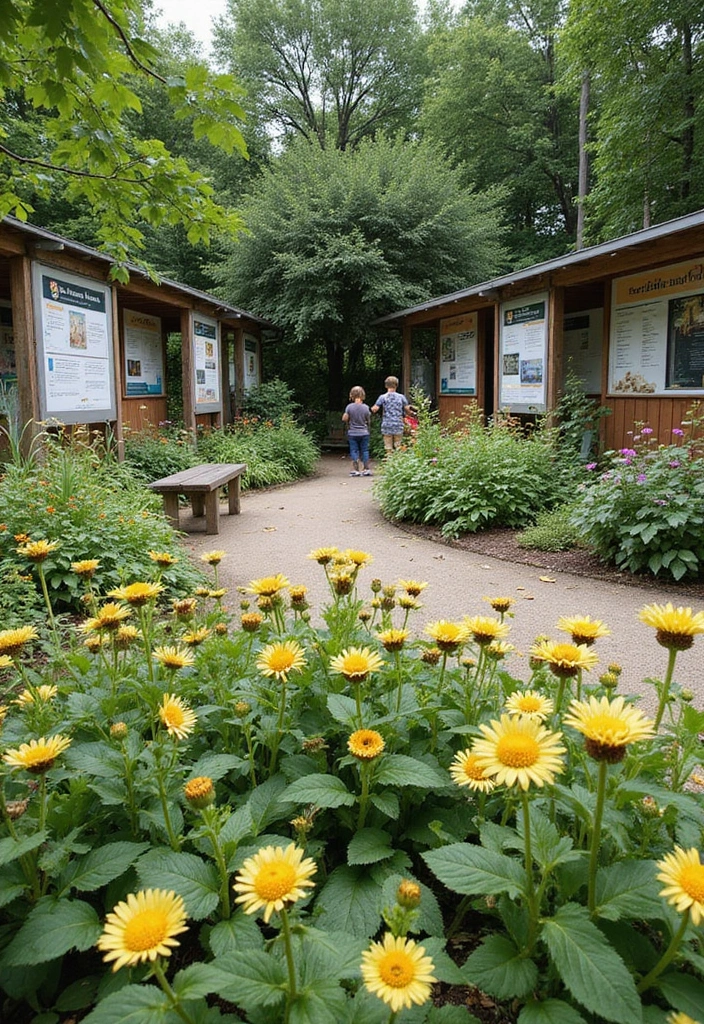
Creating an educational garden with bee balm is a fantastic way to engage children and adults alike in the importance of pollinators. Designate sections of your garden where you can display different plants, including bee balm, and provide information about their benefits to the ecosystem.
Incorporate hands-on activities like planting lessons or butterfly observation stations. The bright colors and unique forms of bee balm are perfect for attracting attention and initiating discussions about gardening and wildlife conservation.
Ensure the garden area is accessible, allowing for easy exploration. This approach nurtures curiosity about nature and encourages sustainable gardening practices among participants.
Engage minds and hearts with an educational garden! Plant bee balm and watch curiosity bloom as you teach the vital role of pollinators in our ecosystem. Let’s cultivate knowledge together!
21. Bee Balm in Seasonal Displays
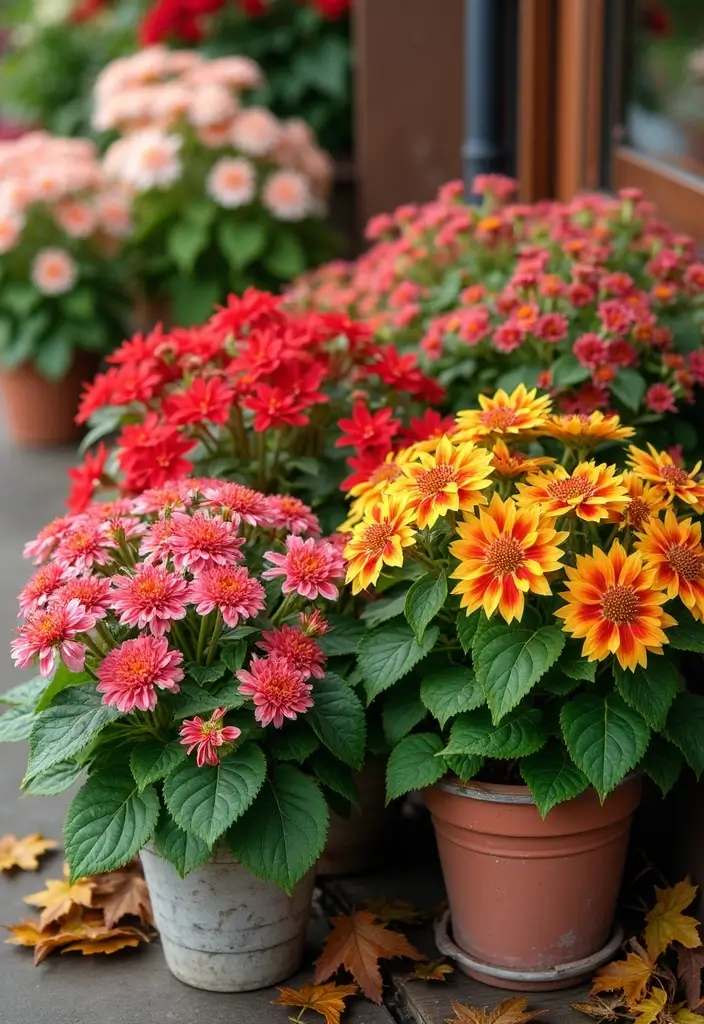
Incorporating bee balm into seasonal displays adds a touch of color and excitement throughout the year. This can involve changing arrangements with seasonal decorations, using bee balm as the focal point during late summer. Combine them with fall-hued plants for a stunning autumn display, or with early bloomers in spring for a true showcase.
These displays can be set up in containers or beds, allowing for easy change and movement. This flexibility enables you to refresh your garden’s look frequently, keeping it inviting and lively.
Consider pairing with ornamental grasses or fall decorations to emphasize the seasonal theme. These arrangements speak to the beauty of seasonal change while nurturing pollinator-friendly practices.
22. Bee Balm for Meditation Spaces
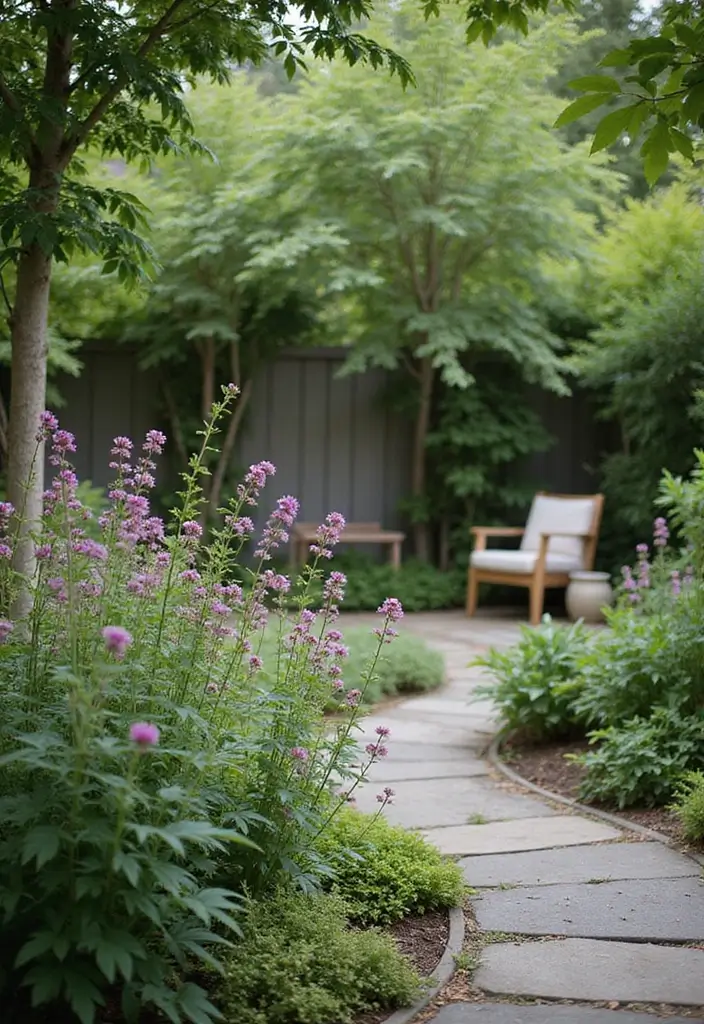
Create a peaceful meditation space in your garden using bee balm as a soothing element. The aromatic leaves and vibrant blooms create a nurturing atmosphere perfect for relaxation and mindfulness. Surround your bee balm with soft greenery and a few comfortable seating options to enhance the tranquility.
Integrating stones or flowing water features can further promote relaxation, making this a true retreat in your backyard. Consider planting aromatic herbs alongside bee balm to enhance the sensory experience during your meditation sessions.
This serene setup not only invites pollinators but also enriches your personal well-being, creating a harmonious biodiversity in your garden.
23. Bee Balm for Aromatherapy
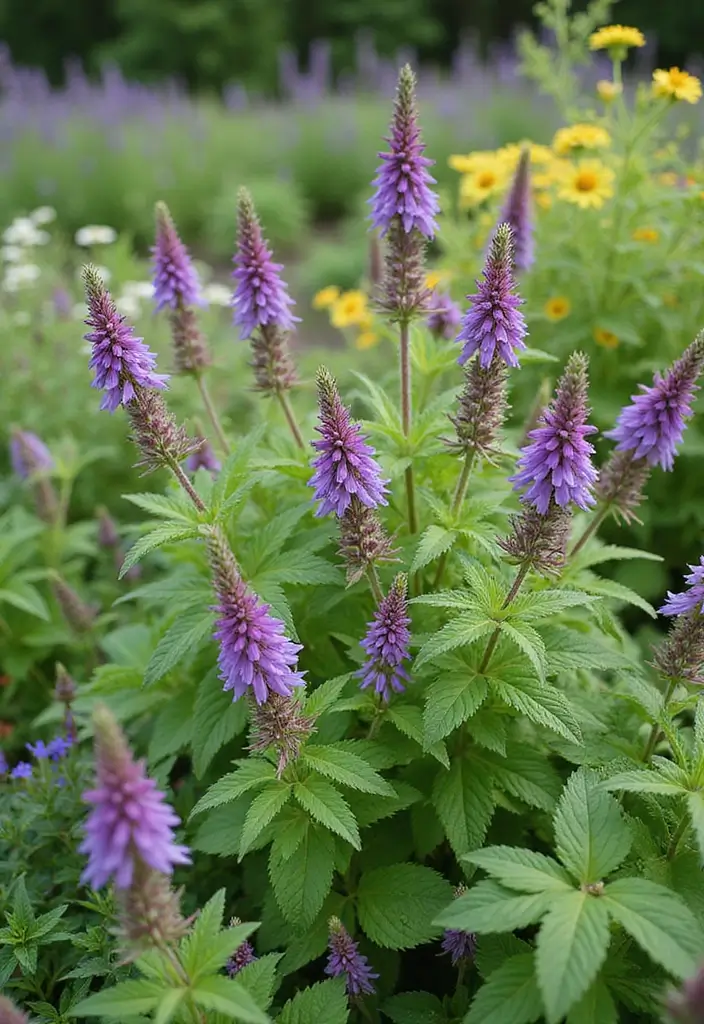
The aromatic leaves of the bee balm plant can play a significant role in aromatherapy gardens. Create a dedicated section where their herbal scent can flourish. Pair them with other aromatic herbs like mint or lemon balm for a multi-sensory experience.
When planning your garden layout, ensure that the bee balm is easily accessible for harvesting leaves. Fresh leaves can be used to brew teas or create soothing essential oils. Consider adding paths lined with aromatic plants, creating a fragrant walking experience.
Regularly pinch back the blooms to encourage new growth and prolonged aromatic benefits. With time and care, this garden will become a lovely retreat for anyone seeking relaxation and rejuvenation.
Unleash the power of the bee balm plant! Its aromatic leaves not only soothe the senses but also create a fragrant oasis in your garden—perfect for teas and essential oils. Breathe deep and enjoy nature’s aroma!
24. Bee Balm as Ground Cover
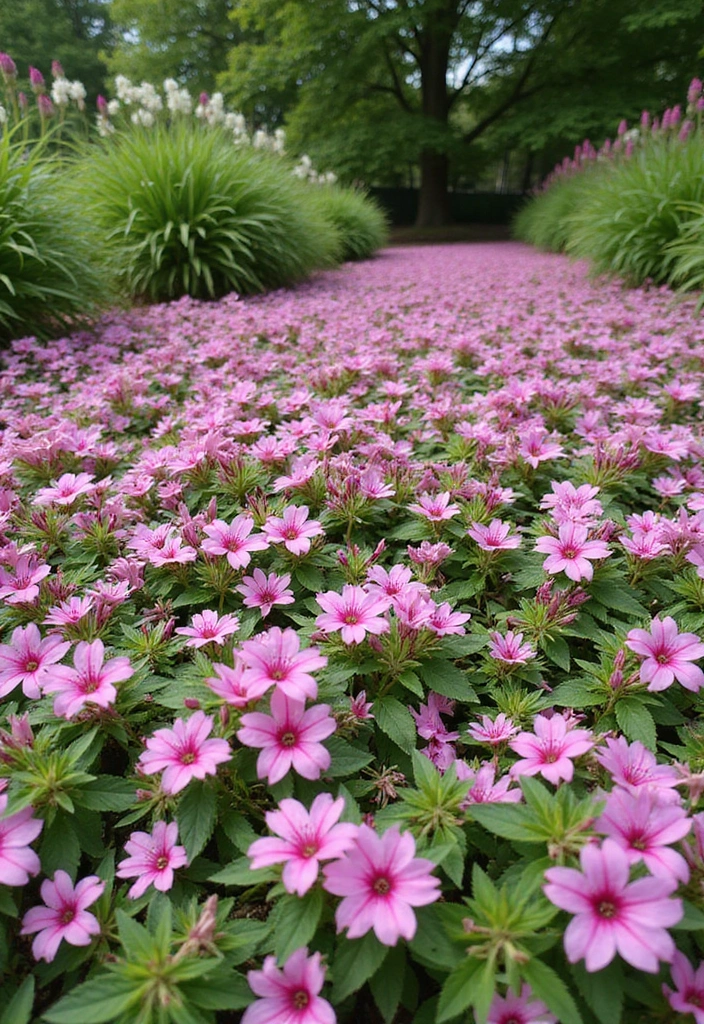
Utilize bee balm as a vibrant ground cover in areas where you want to suppress weeds and add visual interest. Spreading varieties of bee balm can create a colorful carpet of blooms, ideal for filling bare spots in your garden. Combining them with other ground cover plants enhances texture and color.
This strategy is particularly effective on slopes or in challenging areas where other plants may struggle. The dense foliage of bee balm not only beautifies but helps retain soil moisture, promoting a healthy environment for other plants.
Regular maintenance is required to manage their spread, ensuring they don’t overtake other plants. This method adds a bright touch to your landscape while keeping your garden healthy.
25. Bee Balm for Diversity in Pollinator Species

Creating a diverse garden with various bee balm varieties encourages a wider range of pollinator species to visit. This diversity not only enhances the visual appeal but also supports ecosystem health. Mix different colors and types of bee balm alongside other flowering plants to create a rich environment.
By offering different bloom times and forms, you attract various bees, butterflies, and even hummingbirds, creating a lively and interactive space. This multi-species approach can increase the overall health of your garden, as different pollinators fulfill various roles.
Monitor your plants regularly to gauge what attracts the most visitors, allowing for adjustments and improvements over time. This dynamic garden will be a hub of activity, bursting with life and color.
26. Bee Balm for Garden Aromatics
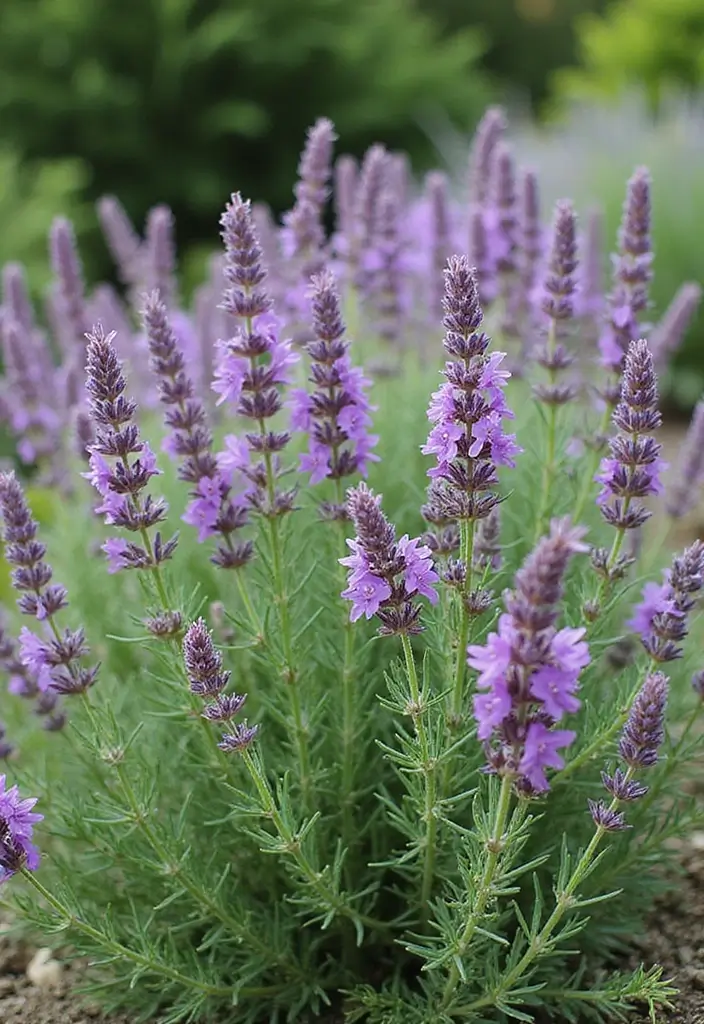
Beyond their stunning visuals, bee balm plants are known for their aromatic properties. Incorporate them into sections of your garden that focus on scent, creating an inviting atmosphere. The leaves can be harvested and used in culinary dishes or teas, adding both flavor and fragrance to your meals.
Consider mixing them with lavender, rosemary, or other aromatic plants to create layers of scent that can linger in the air. Placing these aromatic plants near seating areas or paths enhances the sensory experience of your garden.
Regular harvesting and pruning will not only enhance their aroma but also promote bushier growth and extended blooming periods. This aromatic garden will become a delightful escape for anyone who enjoys the senses.
27. Bee Balm for Natural Fencing
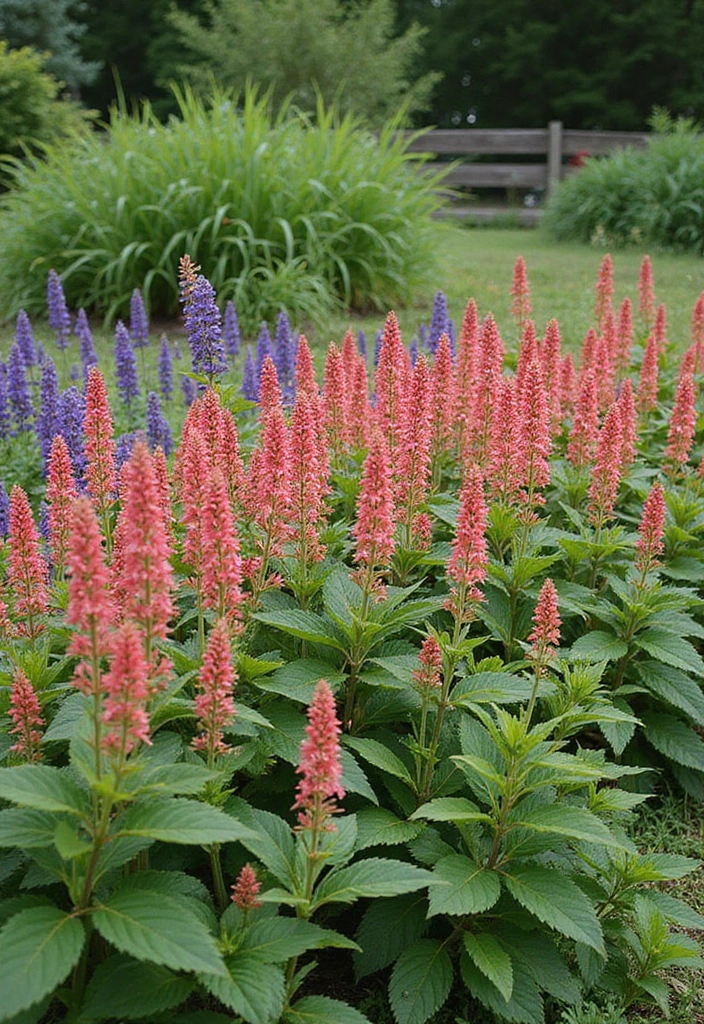
Using tall bee balm as a natural fencing option is an elegant way to mark boundaries while attracting pollinators. Their height can create a natural screen that provides privacy without the need for synthetic barriers. Arrange them in clusters to form a lovely, colorful fence that can also support local wildlife.
Consider planting them alongside other tall perennials or shrubs for added height and depth. This setup not only promotes biodiversity but can also act as a sound barrier, making your space feel serene and secluded.
Regular maintenance, including trimming back in the fall, will keep your natural fence healthy and vibrant. This idea merges functionality with aesthetics, turning boundaries into beautiful spaces.
28. Bee Balm in Community Gardens
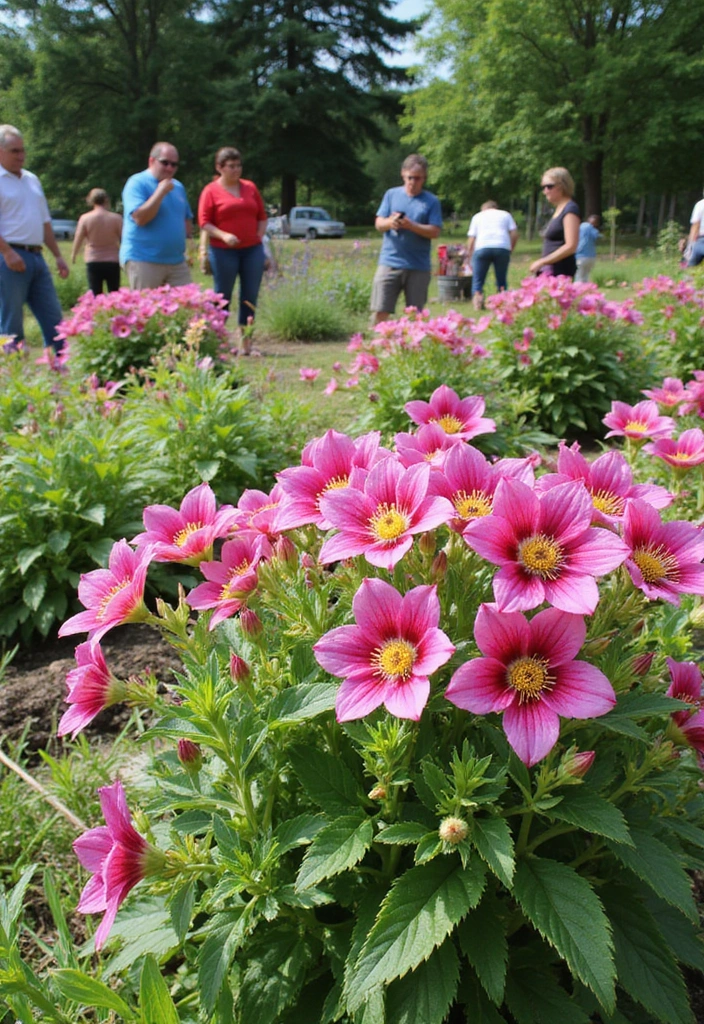
Bee balm is a wonderful addition to community gardens, where its vibrant colors can enhance the collective beauty while supporting local pollinator populations. Partner with fellow gardeners to create a section dedicated to bee balm, allowing everyone to enjoy its charm and benefits.
Encourage learning and collaboration by hosting workshops focusing on bee balm care, propagation, or its uses in cooking and herbal remedies. This shared experience can help foster a sense of community and connection to nature.
Be sure to designate areas for maintenance, ensuring that all members are involved and invested in the plants’ health. This communal effort not only beautifies the space but also strengthens community bonds through shared gardening experiences.
29. Bee Balm for Seasonal Festivals
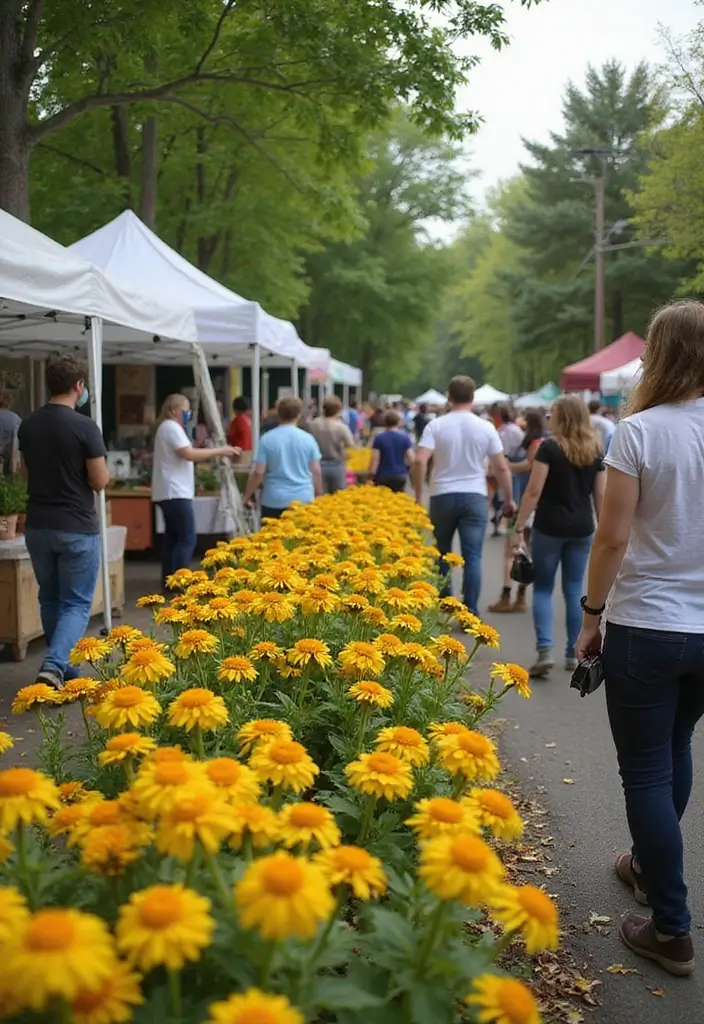
Consider using bee balm in your seasonal festivals or events to highlight their beauty and importance in our ecosystem. Create displays or workshops where visitors can learn about the benefits of pollinator-friendly gardens. Set up booths with fresh bouquets of bee balm available for attendees to take home.
Incorporate activities such as planting demonstrations or educational talks to engage the community in the significance of pollinators. The vibrant blooms will capture attention and serve as a beautiful representation of your commitment to gardening and environmental awareness.
This not only brings excitement to your events but also encourages attendees to consider their gardening practices. Celebrate the joy of gardening while promoting essential ecological practices.
30. Bee Balm for Gardening Therapy
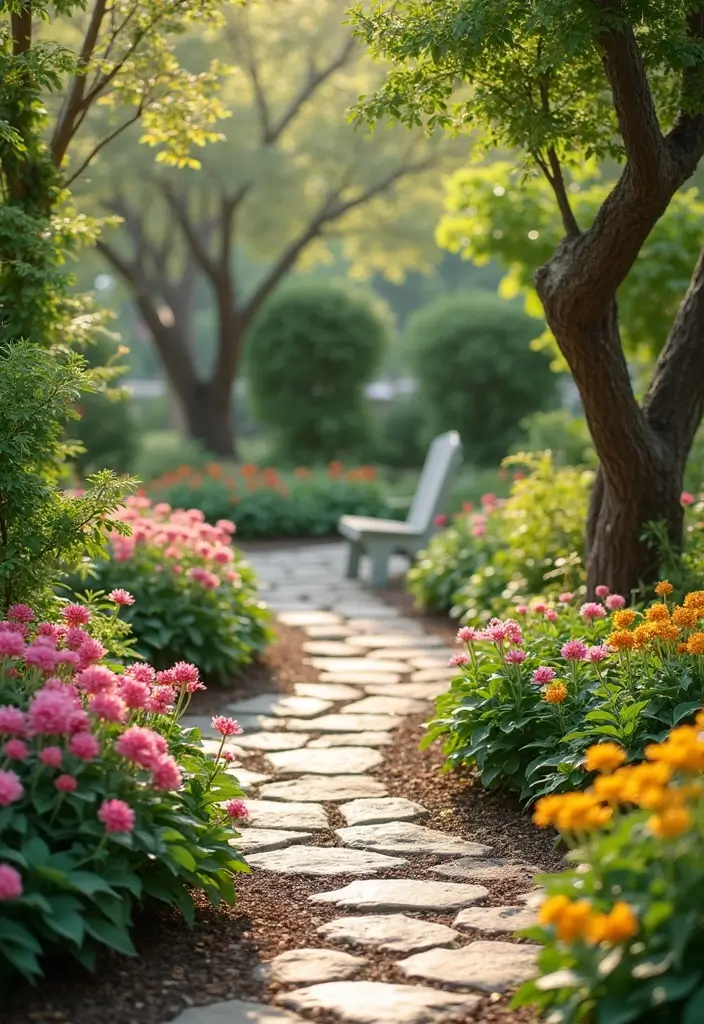
Using gardening as a form of therapy can be incredibly rewarding, and incorporating bee balm plants is a perfect choice. Their vibrant colors and aromatic leaves can uplift spirits and provide a soothing experience. Create a dedicated therapy garden with accessible pathways and seating areas for relaxation.
Consider planning a variety of activities, from planting to simply enjoying the blooms. Engaging in these tasks can help reduce stress and promote mindfulness, making it a therapeutic escape.
Regular care and nurturing of your bee balm can become a fulfilling routine, promoting a strong bond with nature. This garden can serve as a peaceful retreat, allowing you to rejuvenate your mind and spirit.
Conclusion
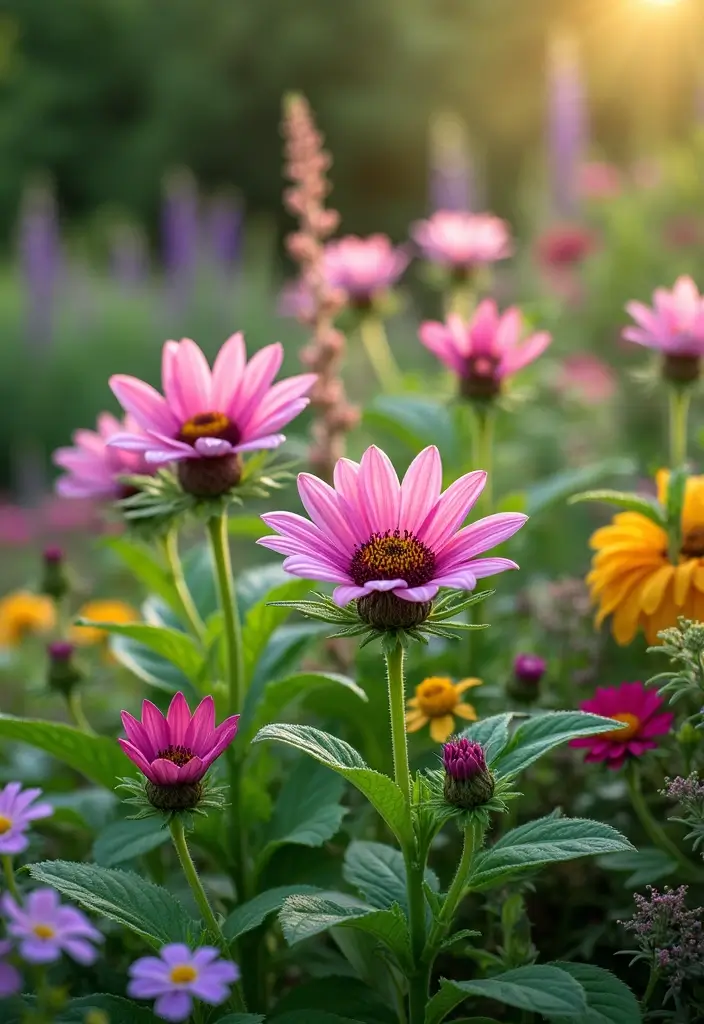
Incorporating bee balm plants into your garden is not just about aesthetics; it’s about creating a thriving ecosystem. From attracting pollinators to enhancing your landscape’s colors, these vibrant perennials offer endless creative opportunities.
Try out some of these ideas to see how bee balm can transform your outdoor space into a beautiful and inviting habitat for both you and the local wildlife. With a little care and creativity, your garden will flourish and become a sanctuary for nature’s most important helpers.
Frequently Asked Questions
What Are the Best Growing Conditions for Bee Balm Plants?
To ensure your bee balm plants thrive, they prefer full sun to partial shade and well-draining soil. They enjoy moisture, especially during their growth phase, but once established, they can tolerate some drought.
Make sure to plant them in a location that has good air circulation to prevent diseases, and consider grouping them with other pollinator-friendly plants to create a vibrant ecosystem.
How Can I Attract More Pollinators to My Garden with Bee Balm?
Incorporating bee balm into your garden is a fantastic way to attract a variety of pollinators, including bees and butterflies. Pair them with other nectar-rich flowers like coneflowers and butterfly bushes for a truly pollinator-friendly garden.
Plant in clusters to create visual impact and make it easier for pollinators to find food. Remember to avoid pesticides, as they can be harmful to these essential creatures!
Can Bee Balm Be Grown in Containers?
Absolutely! Bee balm is perfect for container gardening, making it a great option for patios or balconies. Choose pots with good drainage, and use a quality potting mix to help retain moisture.
Mix different varieties for an eye-catching display, and be sure to water regularly, especially during hot weather. This way, you can enjoy their beautiful colorful blooms even without a traditional garden space.
What Are Some Creative Landscaping Ideas Using Bee Balm?
There are so many creative ways to incorporate bee balm plants into your landscaping! You can create stunning borders along pathways, use them in a cottage garden design, or even mix them into a wildflower meadow for a natural look.
Consider planting them in groups for a bold visual impact, or use them as a natural fence. Their vibrant colors will surely brighten up your garden and attract a variety of wildlife!
How Do I Care for My Bee Balm Plants Throughout the Seasons?
Caring for bee balm is relatively easy! In the spring, ensure they have adequate moisture as they begin to grow. During the summer, regular deadheading will encourage more blooms.
In the fall, cut back the spent foliage to prevent disease and prepare them for winter. Mulching can help protect the roots in colder climates. With proper care, you’ll enjoy their beauty and benefits all season long!
